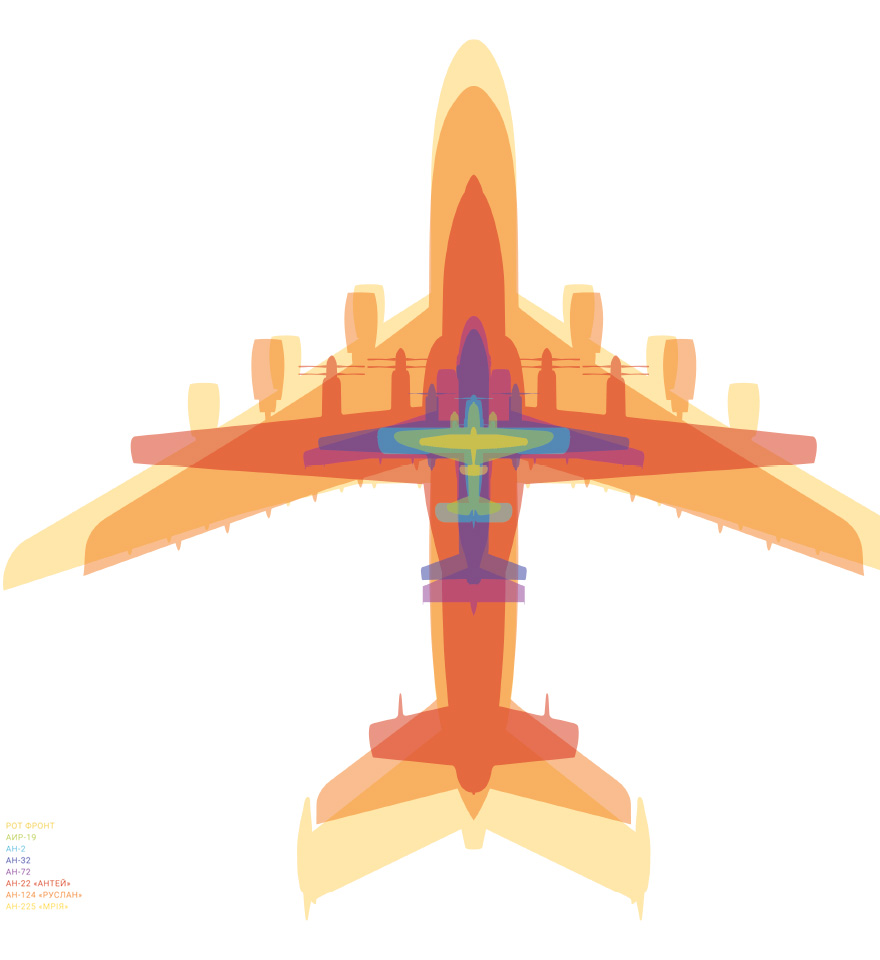AntonovOleg
February 7, 1906, Troitsy village, Russian Empire (now Russia) —
April 4, 1984, Kyiv, USSR (now Ukraine)
An
There is a tradition of naming airplanes after the first letters of the surnames of their chief designers. For instance, Sikorsky’s planes were named S–21, S–22, Kalinin’s planes were named K–1, K–5, K–7, etc. The An planes hide in their name the first letters of the surname of Oleg Antonov. Together with his team, he created more than twenty different ones. What tasks they have not had to perform, what conditions they have not worked in, what records they have not set.

The An–2. Incredibly, the plane, which first took to the skies in 1947, is fstill being mass-produced in China. Another curious thing about An-2 is that it can... It can hang up in the sky for a while, that is, not to move at all and — it’s absolutely fantastic — to move forward with its tail without losing control. The plane has another name — “Kukuruznik”, created as an agricultural plane for taking off from places where there are no runways. The plane needs only a 150–200 m-long stretch of ground to gain momentum and take to the skies. But it was not only the flights from the fields. The modified An–2 on the ski undercarriage was used by the polar explorers during the Arctic and Antarctic expeditions. Overall, in the second half of the 20th century, it seemed difficult to find a person in the Soviet Union who had not flown this plane at least once.
The Аn–32. But no one in the USSR had ever flown this aircraft. It was developed by the Antonov Design Bureau on an order from the Indian Air Force. The Indian military was looking for an aircraft that could take off and land in the Himalayan highlands. At that time there were no other airfields 4 to 4,500 meters above sea level anywhere in the world and therefore no aircraft that could do it. The Аn–32 began to be built in 1975 and in the following year it was piloted in real conditions for the first time. High thrust-to-weight ratio, a characteristic responsible for maximum speed, climb time, acceleration to a required speed, run-up time, flight altitude and maneuvering are essential for such airplanes. It took the Antonov team several years to put the construction in order — the operating conditions were too complicated. But in 1984 they delivered the first nine aircraft to their Indian customers. The customers paid for them not in money but in tea, fabrics and other goods.
Not so long ago, the Indian military reopened the Daulat Beg-Oldie airbase at an altitude of 4 960 meters, closed in 1965. It is the highest in the world. The same Аn–32s are used to interface with the base.
The An–22 Antei. The world saw it on 15 June 1965, when the world’s largest aircraft arrived at the 26th Paris Air Show in Le Bourget. A total of sixty-six such aircraft were produced. They carried humanitarian aid to Peru in July 1970 following an earthquake that killed more than 70,000 people. The five aircraft made 60 flights and carried 250 tonnes of cargo. Later that year, Antei aircraft transported supplies for flood victims in India. In 1984, such aircraft carried cargo to Ethiopia to eliminate consequences of drought and in 1986 they delivered materials for liquidation of the Chernobyl disaster. In addition, Antei aircraft transported parts of future Ruslan and Mriya aircraft. Besides the enormous number of military and rescue operations in which the An–22 was involved, it also set 41 world aviation records and still flies as good as new.
The An–124 Ruslan. The aircraft that departed on 1 December 1990 for a near-earth journey. The route was: Melbourne (Australia) — via Antarctica — refueling in Rio de Janeiro (Brazil) — another refueling in Casablanca (Morocco) — again via the Pole, but now North Pole — refueling in Kamchatka — Melbourne. The flight was extremely difficult. Away from international air routes: most of the time, the An–124 flew over oceans and Antarctica with no landmarks or signals from land-based navigation systems. Seventy smaller aircraft and ships were ready to begin search and rescue operations at any moment. But this was not needed — the aircraft successfully completed the flight. In 72 hours and 16 minutes, the Ruslan flew 50 005 kilometers and set seven world records for air speed.
The rest of Oleg Antonov’s aircraft also hold dozens and hundreds of such incredible stories...
